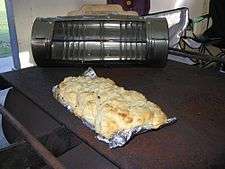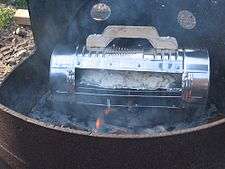Reflector oven


A reflector oven (sometimes known in older cooking literature as a tin kitchen [1]), is a polished metal container, often made of tin. It is designed to enclose an article of food on all but one side, to cause it to bake by capturing radiant heat from an open fire, and reflecting the heat towards the food. In its simplest form, a reflector oven is simply a box or collar that partially surrounds the food, with an open side that faces the heat source, which is generally either a hearth fire or a portable stove, depending on the situation in which the food is being prepared. In Colonial America this method of baking meat, fowl, quick bread, or pastries, was a very popular method for hearth cooking.
A reflector oven that uses the Sun as its primary heat source is known as a solar cooker.
A Dutch oven, was another popular method of baking while using an open fire or a fire in a hearth. The Dutch oven, unlike the tin kitchen, is made of iron, and would collect and concentrate the heat of coals placed beneath and on top of the oven, while preventing the coals from direct contact with the food, and isolating smoke from the fire from the baking food.
A Reflector oven is set beside the fire to capture the radiant heat, and bake with it. It is often tin, new ones are made from aluminum. The picture with this article shows it being set directly on the coals.
Dutch ovens are normally cast iron, with lids, and outdoor fire ones have legs. It is set directly on coals, with additional coals on the top.
See also
References
- ↑ Sloat, Caroline (ed.), Old Sturbridge Village Cookbook, 2ed, Old Saybrook, CT: Globe Pequot Press, 1995, ISBN 1-56440-728-4